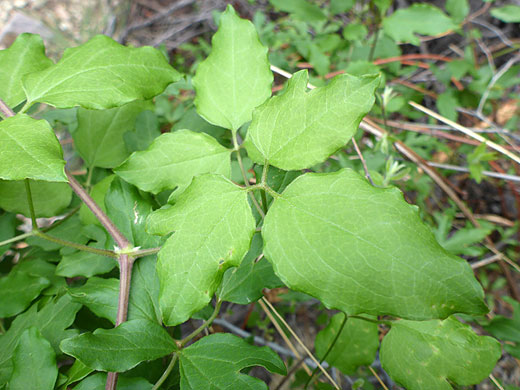
Pendant, bell-shaped flower - clematis pitcheri along the Ward Spring Trail in Big Bend National Park, Texas
Common names:
Purple clematis, Pitcher's leather flower
Family:
Scientific name:
Clematis pitcheri
Main flower color:
Range:
New Mexico, Texas and the southern Great Plains
Height:
Up to 12 feet
Habitat:
Moist woodland, rocky outcrops, often limestone areas; sea level to 7,000 feet
Leaves:
Most are pinnately divided into 3 leaflets, each up to 4 inches long, ovate to widely lanceolate
Season:
March to October
Clematis pitcheri is a vine, with slender stems that are woody around the base, and reach heights, or lengths, of up to 12 feet. The stems are green or reddish, covered by short, smooth hairs, which become less evident with age. Stems are somewhat ridged; angular in cross-section. Leaves are leathery in texture and relatively large, and most are divided into 2 to 8 broad, ovate leaflets which have slightly wavy edges; some leaves are undivided. Leaf surfaces may be hairless (usually), or densely short-hairy.
Between one and seven flowers form from the upper leaf nodes, borne on long stalks. Flowers are pendent, and urn- or bell-shaped; they have four purple or bluish sepals, fused for most of their length, wide at the base and narrower above. The sepal tips are rolled back by 360 degrees, revealing numerous thin, greenish sepals around a group of slightly longer green pistils. Sepal margins are irregularly fringed, and the sepal tips are often lighter in color.
This is very variable species, especially in leaf divisions, fruit hairiness and sepal characteristics, though there are only two named varieties. Var pitcheri has large (up to 4 inches long), thin leaflets, and hairy stamen filaments, while var dictyota has smaller (up to 1.5 inches long), leathery leaves and hairless filaments.
Between one and seven flowers form from the upper leaf nodes, borne on long stalks. Flowers are pendent, and urn- or bell-shaped; they have four purple or bluish sepals, fused for most of their length, wide at the base and narrower above. The sepal tips are rolled back by 360 degrees, revealing numerous thin, greenish sepals around a group of slightly longer green pistils. Sepal margins are irregularly fringed, and the sepal tips are often lighter in color.
This is very variable species, especially in leaf divisions, fruit hairiness and sepal characteristics, though there are only two named varieties. Var pitcheri has large (up to 4 inches long), thin leaflets, and hairy stamen filaments, while var dictyota has smaller (up to 1.5 inches long), leathery leaves and hairless filaments.
All Contents © Copyright The American Southwest | Comments and Questions | Contribute | Site Map


